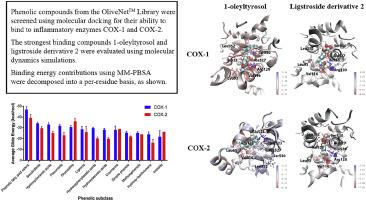Journal of Molecular Graphics and Modelling ( IF 2.7 ) Pub Date : 2020-08-26 , DOI: 10.1016/j.jmgm.2020.107719 Julia Liang 1 , Natalie P Bonvino 1 , Andrew Hung 2 , Tom C Karagiannis 3

|
Non-steroidal anti-inflammatory drugs (NSAIDs) are widely used to reduce pain. These target cyclooxygenase (COX) enzymes which produce inflammatory mediators. Adverse effects associated with the use of traditional NSAIDs have led to a rise in the development of alternative therapies. Derived from Olea Europaea, olive oil is a main component of the Mediterranean diet, containing phenolic compounds that contribute to its antioxidant and anti-inflammatory properties. It has previously been found that oleocanthal, a phenolic compound derived from the olive, had similar effects to ibuprofen, a commonly used NSAID. There is an abundance of olive phenolic compounds that have yet to be investigated for their anti-inflammatory properties. In this study, it was sought to identify potential olive-derived compounds with the ability to inhibit COX enzymes, and study the mechanisms using in silico approaches. Molecular docking was employed to determine the COX inhibitory potential of an olive phenolic compound library. From docking, it was determined that 1-oleyltyrosol (1OL) and ligstroside derivative 2 (LG2) demonstrated the greatest binding affinity to both COX-1 and COX-2. Interactions with these compounds were further examined using molecular dynamics simulations. The residue contributions to binding free energy were computed using Molecular Mechanics-Poisson Boltzmann Surface Area (MM-PBSA) methods, revealing that residues Leu93, Val116, Leu352, and Ala527 in COX-1 and COX-2 were key determinants of potential inhibition. Along with part 2 of this study, this work aims to identify and characterise novel phenolic compounds which may possess COX inhibitory properties.
中文翻译:

在计算机上表征橄榄酚类化合物作为潜在的环氧合酶调节剂。第1部分。
非甾体抗炎药(NSAIDs)被广泛用于减轻疼痛。这些靶向环氧合酶(COX)产生炎症介质。与使用传统的非甾体抗炎药相关的不良反应导致替代疗法的发展。源自Olea Europaea,橄榄油是地中海饮食中的主要成分,其中含有有助于其抗氧化和消炎特性的酚类化合物。先前已经发现,油橄榄酚,一种衍生自橄榄的酚类化合物,与通常使用的NSAID布洛芬具有相似的作用。橄榄酚类化合物的抗炎特性尚待研究。在这项研究中,寻求鉴定具有抑制COX酶能力的潜在的橄榄衍生化合物,并使用计算机技术研究其机理。方法。分子对接用于确定橄榄酚类化合物库的COX抑制潜力。通过对接,确定1-油基酪醇(1OL)和糖脂苷衍生物2(LG2)对COX-1和COX-2表现出最大的结合亲和力。使用分子动力学模拟进一步检查了与这些化合物的相互作用。使用分子力学-泊松玻尔兹曼表面积(MM-PBSA)方法计算残基对结合自由能的贡献,表明COX-1和COX-2中的残基Leu93,Val116,Leu352和Ala527是潜在抑制的关键决定因素。与本研究的第2部分一起,这项工作旨在鉴定和表征可能具有COX抑制特性的新型酚类化合物。











































 京公网安备 11010802027423号
京公网安备 11010802027423号